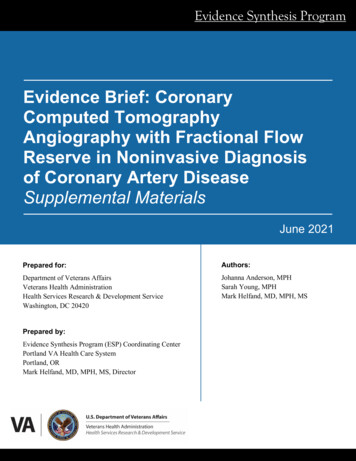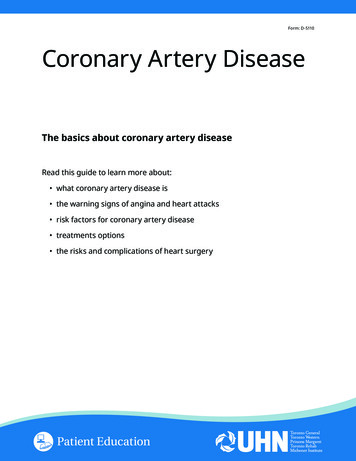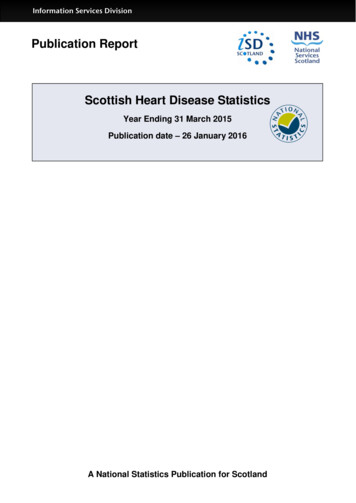
Transcription
GUIDE CATHETERS FORCORONARY INTERVENTIONSreeyam Srikanth
Diagnostic vs Guide catheters Stiffer shaft Larger internal diameter (ID) Shorter & more angulated tip (110º vs. 90º), non tapering atraumatic tip Re-enforced construction (3 vs. 2 layers).
Parts of a Catheter Usual length 100 cm
Catheter size Outer diameter French size (5-10F) Inner diameter Inches Length in cm ( usually 100 cm)
Cross section of catheterStrengthSupport/FlexibilityKink resistancePolyurethaneorPolyethylene1:1 TorqueKink resistanceStainless steel/KevlarInternal lumenSmooth or lubriciousmaterialDevice compatibilityPTFE(Polytetrafluoroethylene)like Teflon
Important features of a guide catheter Preformed curves & configurations, optimumsupport Adequate lumen & device compatibility Easy to handle, torque control, kink resistance A traumatic tip
Side hole vs no side holeSide holes are useful where the pressure gets frequently damped as in RCAinterventions, CTO interventions or sole surviving artery or left maininterventionsAdvantages Prevent catheter damping (occlusion of the coronary ostium) Allow additional blood flow out of tip, to perfuse the artery. Avoid catastrophic dissections in the ostium of the arteryDisadvantages False sense of security because now, aortic pressure, and not thecoronary pressure is being monitored. Suboptimal opacification Reduction in back up support provided because of weakness ofcatheter shaft and the kinking at side holes
Guide catheters ADROIT Guiding Catheter VISTA BRITE TIP Guiding CatheterCordis Wiseguide Guide CatheterRunWay Guide CatheterMach 1 Guide CatheterConvey Guiding CatheterBoston scientific Launcher Coronary Guide CatheterSherpa NX Active Coronary Guide CatheterSherpa NX Balanced Coronary Guide CatheterMedtronic
Guide catheters sizes
Guide catheters are available as standard, largeand giant catheters based on the internaldiameter
Guide selection Diagnostic curve selectionSize of the ascending aortaOrigin and takeoff of the target arteryDegree of tortuosity and calcification of the coronaryartery segment proximal to the target area Device to be utilized during intervention
Smaller vs larger catheter
Selection of guiding catheter Size Shape/curve Length
Compa5bility with devices and techniquesSize of the catheterCatheter SizeDevicesTechniques5FrBalloons 5 mmStents 4.5 mmIVUSRotablator1.25 mm burrNo Kissing Balloon6 FrAll Coronary balloonsAll Coronary stentsCuttinng BalloonRotablator 1.5 mmCSI orbital atherectomy 1.25mmProtection deviceGuidelinerKissing Balloon7Fr8FrRotablator1.75 mmGuidelinerTrapping balloonsRotablator 2 mmGuidelinerTrapping balloonsSimultaneous Kissing StentTrifurcation stenting
Curve selection factors Aortic WidthCoronary AnatomyFrench SizeActive vs. Passive SupportNative Coronary vs. CABGAmount of Calcium in Target Vessel
Aortic widthwww.medtronic.com
Back-Up Support Ability of the guiding catheter to remain in position andprovide a stable platform for the advancement ofinterventional equipment There are 3 main types of back up support Passive Active Balanced
Passive support Strong support given by inherent design of a guide with good back-up againstopposite aortic wall stiffness from manufactured material Additional manipulation is generally not required Mainly passive Amplatz
Active support Active support is typically achieved by1. Manipulation of the guide - into a configurationconforming the aortic root2. Deep-Seating - Intubation with deep engagement of theguide into the coronary vesselsBalanced Support Rely on the inherent property of shaft and shape for coaxiallity, butcan be manipulated in cases requiring extra support Judkins EBU
Determinants of back up support 3 factors Catheter size Angle theta of the catheter on the reverse side of aorta Contact area
Determinants of back up support Role of q - If q is larger and close to 90 the backup force is greater If Fcosq l (static friction),the guiding catheter works. If Fcosq l, system collapses.llFmax ――――cosq
Guide Catheter Selection * MOST IMPORTANT REQUIREMENT: CO-AXIAL ALIGNMENTNon-CoaxialCoaxial
Guiding Catheter SupportJR4Simple coaxial alignment,without supportHockey StickCoaxial alignment, withextra support from Sinus ofValsalvaEBUCoaxial alignment, withpower support fromopposite wall of aorta
Most commonly used guides Judkins, Amplatz, and Extraback-up guides Others include - Multipurposefor RCA bypass or a high leftmain (LM) takeoff LIMA catheter for - right andleft coronary bypass graft
Guiding Catheter Selection - LCAAortic root Normal JL4 Dilated JL 5, AL 2,VL 4, , XB 4, EBU 4 Narrow JL3.5,VL3.5, XB3.0, EBU3.5Orientation* Normal, Anterior JL, AL, VL, XB, EBU Posterior AL, VL, XB, EBU Superior JL, VL, XB, EBU
The Judkins Guide Primary (90º), secondary (180º),and tertiary (35º) curves fit aorticroot anatomy As 1⁰ curve fixed Intubates smallsegment of ostium - risk oftrauma Engage the LM ostium withoutmuch manipulation knows where to go unlessthwartedby the operator
JUDKINS GUIDE Selected according to width of the ascending aorta location of the ostia to be cannulated orientation of the coronary artery segment proximal to the target lesion Segment between the primary and secondary curve of theJudkins left guide should fit width of ascending aortaex:3.5 cm,4 cm, 4.5 cm
Aortic width450Co-axial alignment withat theprimary curve and the secondarycurve buttressing at the C/L wallCurve length distance between P(primary curve) & S (secondary curve) Aortic diameter determines the curvelength
Limitations of Judkins Guide As 1⁰ curve is fixed - may not be co-axial with the artery may be difficult to pass balloons - as catheter makes an angleof 90º with ostium JL- point of contact on ascending aorta - very high & narrow chance of prolapse & dislodgement JR- no point of contact on asc Aorta - extremely poor support
The Amplatz Guide Secondary curve rest against thenoncoronary posterior aortic cusp Offers firm platform foradvancement of device Best in the case of a short LM, withdown going left circumfl ex artery(LCX) Tip points slightly downward higher danger of ostial injurycausing dissection
Amplatz Guide Selection of the proper size foran Amplatz guide is essential Size 1 is for the smallestaortic root size 2 for normal size 3 for large roots Attempts to force engagementof a preformed Amplatz guidethat does not conform to aparticular aortic root increaserisk of complication
Withdrawal of an Amplatz Guide Must be carefully disengaged from the coronary artery A simple withdrawal from the vessel can cause the tip toadvance farther into the vessel and cause dissection To disengage - first advance guide slightly to prolapse the tipout of the ostium Then rotate the guide so that tip is totally out of the ostiumbefore withdrawing it
Withdrawal of an Amplatz Guide After BalloonInflation After deflation if balloon is pulled out, the tip of the Amplatz(or any) guide would have the tendency to be sucked indeeper To avoid this - pull the balloon out while simultaneouslypushing the guide in - to prolapse the guide out
Extra-Back-Up Guide Long tip forms a fairly straight linewith the LM axis or the proximalostial RCA Long secondary curve - abut theopposite aortic wall So tip in the coronary artery is noteasily displaced Provide a very stable platform
JL and EBU sizing
Long tip catheters Voda, XB, EBU Advantages coaxial intubation better support and stability precise control andmanipulation lack of bends -improveadvancement ofdevices,decrease the loss ofsupportive forces safety
RCA interventions Usual - JR or Hockey stick guide If extra support - CTO, tortuosity – AL1 Abnormal take off of RCA from aorta esp info orientations MP guide Tortuous or bent anatomy, posterior and superior take off ofRCA - 3DRCAortic root Normal JR4, AL1, AR1 Dilated JR 5, AL 2, AR 2 Narrow JR 3, AL 0.75
Shepherd’s crook deformity of RCADramatic upturn witha near 180 degreeswitch back turnwww.medtronic.com
Other catheters 3 DRC - Three dimensional right curve - for tortuous, bentanatomy and posterior or superior take off of RCA Arani Double angle 90 º curve sits on ascending aorta in Sconfiguration and is therefore useful for RCA with horizontaltake-off & shephered crook RCA Primary and secondary curve provides two contact points onthe opposite side of aorta thusproviding tremendous back-up support
XBR and XBRCA - new catheters developed specifically for theinferior and superior take off of RCA respectively El Gamal (EGB) - pre-shaped catheter with improved distalend-portion for accessing bypass grafts and more preciseaccess of RCA LCB - for left coronary venous bypass grafts. Its tip has 90 ºbend with 70º secondary bend RCB - for right coronary venous bypass grafts, its tip andsecondary bends approximate 120º - like a JR catheter with ashallower tip bend
If tip does not reach the ostium and keep lying below it guide is too small If tip lies above the ostium - guide is too large When RCA ostium is very high - left Amplatz guide may beused to engage the right ostium
Multipurpose Guide Straight with a single minor bend at the tip For RCA bypass graft or a high left main (LM)takeoff
GUIDE MANIPULATION
Standard safety techniques Basic safety measures should be applied rigorously whenmanipulating guides 1 . Aspirate the guide vigorously after it is inserted into the ascending aorta forany thrombus or atheromatous debris floating 2 . Insist on generous bleed back to avoid air embolism 3. Flush frequently to avoid stagnation of blood inside the guide 4 .Constantly watch the tip when withdraw interventional device especially withostial or proximal plaques 5 .Watch the blood pressure curve for dampening to avoid inadvertent deepengagement of the tip 6 .During injection, keep the tip of the syringe pointed down so any air bubbleswill float up and are not injected
Advancement Through Tortuous Iliac Artery Excessive tortuosity - rotations at the proximal end do nottransmit similar motion to the distal tip Guide can twist on itself Methods to advance 23 cm sheath may help to overcome the iliac tortuosity Abdominal aortic aneurysm - 40 cm sheath is needed Torquing a guide still cannulated inside by a stiff 0.38 wire
Dampening of Arterial Pressure Guide can cause fall of diastolic pressure - ventricularization fall of both systolic and diastolic pressure - dampenedpressure Can be due to significant lesion in the ostium coronary spasm non-coaxial alignment mismatch between diameter of the guide and of thearterial lumen
Checking Stability and Potential of Backup Capability Forward advancement of guide should furtherintubate the coronary artery rather than prolapse intothe aoric root If tip slips out - guide does not provide sufficientbackup Need to be changed for another with better support Active intubation of the guide may be tried if its tip is soft if the artery is large enough to accommodate the guide no ostial or proximal lesions Active support position is needed temporarily in orderto advance the device across the lesion Once device is positioned guide is withdrawn toostium.
Techniques to Stabilize a Guide1. Second angioplasty wire/ Buddy Wire - advanced parallel to thefirst one Straightens tortuous vessel and provides better support fordevice tracking2. Second wire in a side branch - useful in anchoring the guide(second wire in LCX when dilating LAD lesion) Provides for better backup and allows retraction of the guidewhen necessary, without loss of position Also prevents the guide from being sucked in beyond the LMwhen pulling back balloon catheters Cause unnecessary denudation of endothelium in that vessel
Techniques to Stabilize a Guide3.Change to stronger guide4. Anchoring Balloon Second small balloon (1.5–2 mm diameter) inserted in a smallproximal branch Inflated at 2 ATM - anchor the guide5 . Change the current sheath to a very long sheath6 . Double guide technique insert a smaller guide in current guide
How to Untwist a Twisted Guide Move the twisted segment to a large area by advancing it intoto the aorta Cannulate the guide with a 0.035 wire Move its tip to the twisted area Next try to untwist the guide by torquing in the oppositedirection Slowly advance the wire to secure the segment just untwisted
Avoiding Selective Entry of the Conus Brancho If the guide keeps entering the conus artery change the guide for a larger one approach the RCA from a posterior direction position the guide above the sinus, rotate theguide counterclockwise to enter the main RCAfirst
Deep-Seating If the guide needs to be deepseated then it is advanced over aninterventional device Apply clockwise/counterclockwise torque Once deep-seated device isadvanced and positioned After achieving the position guideis withdrawn with gentle rotation
Deep-seating Attempted only if Artery is large enough to accommodate the guide No ostial or proximal lesion Guide tip is soft Direction of torquingToward the LAD Counter-clockwise rotationToward the LCX and RCA Clockwise rotation
Shows a superiorly orientated “shepherd’s crook” RCA andappropriate catheter engagement. (a) Where using a Judkinsright catheter results in non-coaxial engagement of the RCAostium. (b) Where using a guiding catheter with a superiorlydirected tip (e.g. Amplatz left) results in coaxial engagement ofthe RCA ostium
Showing how RCA may originate from an increasingly anterior position, requiring adifferent catheter shape to cannulate the ostium successfully. (a) Normal RCA origin –JR catheter engages coaxially. (b) Slightly anterior RCA origin – hockey stick catheterengages better than JR catheter. (c) Significantly anterior RCA origin – JR catheter willnot engage, Amplatz left catheter here shown in a rotated plane with appropriatesecondary curve length and shape to cannulate the RCA ostium coaxially
Coronary AnatomyOstial OriginsLeft Main - usually arises anterior, inferior and leftwardfrom the left coronary sinusLAD - usually arises in an anterior and superior positionLCX - usually arises posterior and inferior from the leftmainRCA - usually arises anterior from the right aortic cuspSVGs - usually arise from the anterior portion of theheart
Coronary Anatomy Ostial VariationsCoronary ostial location: high low anterior posteriorCoronary ostial orientation: superior horizontal inferior shepherd’s crook (RCA’s only)
Coronary Artery Variations
Common Takeoffs- Left Coronary Artery HorizontalInferiorSuperior
Common Takeoffs Right CoronaryArteryHorizontalInferiorSuperior
Short and long LMCA If the LM is short and there is no acute angle at thebifurcation with the LCX - left Judkins If the LM is long and the angle between the LM and LCX isacute - extra-backup guide Tip of the guide is very close to the ostium of the LCX so theacuity of the LM and LCX angle is nullified making smootherthe transition between the LM and LCX
GUIDES FOR CORONARY ANOMALIES Important to be aware of variations of coronary anomalies Systematically search in other aortic sinuses when the vesselin question does not arise Anomalous artery from the right sinus Left, right Amplatz ,Multipurpose Anomalous artery from the left sinus Larger left Judkins ,Left Amplatz ,Multipurpose
Guides for Anomalous Coronary Arteries Arisingfrom the Left Sinus When RCA arises from the left cusp usually it is anterior andcephalad to LM Judkins left with secondary curve one size larger than oneused for the patient’s LM Pushed deep in the left sinus of Valsava, causing it to make ananterior and cephalad U-turn Larger curve will prevent guide to engage LM
Missing arteries Guide selection Missing LCX due to very short LM - Use large guide with shorttip and turn clockwise to point the tip more posteriorly No RCA In right sinus - Amplatz left pointing antero-superior tothe RCA ostium No RCA In left sinus - Judkins left one size larger, pointingantero-superior to the LM ostium
SVG and LIMA Usual – JR Abnormal positions and take offsMP or AL1 LCB/RCB Internal mammary artery - IMAcatheter , LCB IMA Catheter is designed forboth Rt. And left InternalMammary arteries shaped like a JR catheter butwith a steeply angled tip (80 to85º).LCBIMA
Choice of Catheters for Interventionsvia Radial Artery Left coronary artery: down size JL by 0.5Judkins left , Amplatz left , Multipurpose , EBUIKARI left , El GamalRight coronary arteryJudkins right, Amplatz right, Amplatz left MultipurposeIKARI right, El Gamal
Ikari catheter – for trans radial interventionIkari R (IR) 1.5Ikari L (IL) 4
resistance (gram force)1009080706050403020100JL4θiθjIL4
Sheath less Guide Catheters DuringTransradial PCIThe Sheath Less guiding catheter is designed to: Minimize the radial puncture site whilstproviding a larger inner lumen Negates the need for a sheath during PCI Hydrophilic coating enhances cathetertrackability Long dilator provided with each catheter
Sheathless Eaucath system (Asahi InteccCo Ltd.)
The Sheath less Eaucath system with integrated central introducer tailoredfor minimal clearance over a 0.035-inch wire and interface with the innerlumen of the guiding catheter. The shape of the guiding catheter becomes apparent after the centraldilator and wire are removed in the central aorta.
Guide extension(Mother and child) Improve the delivery ofcoronary stents to complexlesions Child catheters 4/5 F 120 cm Mother catheter - 6 Fguiding catheter 100cm Superior trackability of the4F child catheter Increased backup support ofthe mother-child system
Guide liner catheter Guide Liner catheter is a coaxial guiding catheter extensiondelivered through a standard guiding catheter on a monorail Comprises a flexible yellow 20 cm straight extensionconnected to a stainless-steel push tube Permits very deep intubation of the target vessel, thusproviding backup support to facilitate stent delivery acrossheavily calcified lesions in tortuous vessels
Guide liner catheter
Heartrail II - PTCA guiding catheter Hear trail II is developed to maximize yourback-up force when using right and left Ikaricurves during transradial interventions andthrough its innovative 5-in-6 system. By inserting a 5 Fr (120 cm with flexible distalportion) into a 6 Fr guiding catheter: Provides the back-up support of a 7 Fr guidingcatheter with a 6 Fr system
NAMES OF GUIDE CATHETERS FROMDIFFERET COMPANIESBOSTON SCIENTIFICCONVEYGUIDEZELLA GUIDEEXTENTION CATHETERMACH 1RUBICON SUPPORTRUNWAYWISEGUIDEMEDTRONIC LAUNCHERCORDIS GUIDE CATHETERPORTFOLIO – COMPOSEDOF ADROIT GIDE CATHETERAND VIST BRTIE TIPMERIT MEDICAL CONCIERGE
Curve typeStandardcurvesShape typeAmplatz LeftAmplatz RightJudkins LeftJudkins RightShape codeAL 1AL 2AL 3AR 1AR 2JL 3JL 3.5JL 4JL 4.5JL 5JL 6JR 3JR 3.5JR 4JR 4.5JR 5JR 6StrongerbackupcurvesOther curvesCurvesfor bypassCurvesfor radialaccessBack Up for left coronaryBack Up for rightcoronaryMultipurposeIMABypassIkari-Curve LeftIkari-Curve RightTigerJR CatarinaVD Radial5 in 6 systemBL 2.5BL 3BL 3.5BL 4BL 4.5BR 3.5BR 4MPA-LargeIMA 1.0BP-LBP-RIL 3IL 3.5IL 4IL 4.5IR 1IR 1.5IR 2TIG 5ER 4VDR-LStraight
THE END
Size of the catheter Catheter Size Devices Techniques 5Fr Balloons 5 mm Stents 4.5 mm IVUS Rotablator1.25 mm burr No Kissing Balloon 6 Fr All Coronary balloons All Coronary stents Cuttinng Balloon Rotablator 1.5 mm CSI orbital atherectomy 1.25 mm Protection device Guideliner Kissing Balloon 7Fr Rotablator1.75 mm Guideliner Trapping balloons









